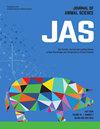日粮钙和维生素 D 补充剂对后备母猪血浆骨转换生物标志物、骨矿化、骨强度和跛行评分的影响。
IF 2.7
2区 农林科学
Q1 AGRICULTURE, DAIRY & ANIMAL SCIENCE
引用次数: 0
摘要
本研究调查了钙和维生素 D 补充剂对后备母猪骨代谢、骨骼测量、跛足和选择率的影响。两种钙水平(6.85/6.42 [足量;ACa] 或 8.99/8.56 [高量;HCa] 克/千克)与 856 IU/千克维生素 D3(丹麦饲养标准;足量;AD3)或 50 μg/kg 25-羟维生素 D3(高量;HHyD)相结合,制成 ACaAD3、HCaAD3、ACaHHyD 和 HCaHHyD 日粮。6.85/6.42和8.99/8.56克/千克的数值分别对应于体重(BW)为32至100和100至180千克的后备母猪的充足和高钙供应量。第五种日粮是 HCa 和 2,000 IU/kg 维生素 D3(高;HD3)的组合,即 HCaHD3。两百头后备母猪在体重 32 至 100 千克和 100 至 180 千克期间分阶段饲喂这些日粮,直到体重达到 100 或 180 千克时宰杀。每两周对后备母猪称重一次,并在体重为 100 和 180 千克时采集血浆和尿液样本。屠宰时,收集第 2 和第 3 掌骨以测量骨参数。在体重分别为 100 kg 和 180 kg 时,在最后 7 d 内对跛行和选择率进行评估。日粮处理对后备母猪的生长性能和血浆中钙的浓度没有影响,但补充 HCa 的后备母猪在体重为 100 kg(P = 0.003)和 180 kg(P = 0.05)时尿中钙的浓度更高。血浆中的维生素 D3(P < 0.001)和 25-羟维生素 D3(P < 0.001)浓度在体重为 100 和 180 千克时均呈现剂量依赖性反应。饲喂 HCaHD3 日粮的后备母猪在体重达到 180 千克时采集的血浆样本中骨骼特异性碱性磷酸酶更高(P = 0.02),而饲喂 ACaAD3 日粮的后备母猪的骨骼特异性碱性磷酸酶往往更高(P = 0.06)。与饲喂 ACaAD3 和 ACaHHyD 日粮的后备母猪相比,饲喂 HCaAD3 日粮并在 100 千克体重时屠宰的后备母猪骨灰含量更高(P = 0.02)。然而,在体重为 100 和 180 千克时,不同日粮处理的母猪骨重、长度、厚度、干物质和矿物质含量均无差异(P > 0.05)。日粮处理对跛行和选择率均无影响。体重 32 至 100 千克和 100 至 180 千克的后备母猪的平均日增重分别与骨强度(r = 0.37;P < 0.001)和骨灰含量(r = 0.24;P = 0.02)呈正相关。总之,与按照丹麦营养标准饲喂的后备母猪相比,补充较高的钙和维生素 D3 会略微增加骨灰含量,但对跛足或选择率没有影响。本文章由计算机程序翻译,如有差异,请以英文原文为准。
Effect of dietary calcium and vitamin D supplements on plasma bone turnover biomarkers, bone mineralization, bone strength, and lameness score in gilts.
This study investigated the impact of calcium (Ca) and vitamin D supplements on bone metabolism, bone measurement, lameness, and selection rate in gilts fed five dietary treatments. Two Ca levels (6.85/6.42 [adequate; ACa] or 8.99/8.56 [high; HCa] g/kg) were combined with either 856 IU/kg vitamin D3 (Danish feeding standards; adequate; AD3) or 50 μg/kg 25-hydroxyvitamin D3 (high; HHyD) to create ACaAD3, HCaAD3, ACaHHyD, and HCaHHyD diets. The values 6.85/6.42 and 8.99/8.56 g/kg correspond to adequate and high Ca supply for gilts weighing 32 to 100 and 100 to 180 kg body weight (BW), respectively. The fifth diet was a combination of HCa and 2,000 IU/kg vitamin D3 (high; HD3) to create HCaHD3. Two hundred gilts were phase fed the dietary treatments from 32 to 100 and 100 to 180 kg BW until they were slaughtered, either at 100 or 180 kg BW. The gilts were weighed fortnightly, and plasma and urine samples were collected at 100 and 180 kg BW. At slaughter, the 2nd and 3rd metacarpal bones were collected for bone parameters measurements. Lameness and selection rate were assessed within the last 7 d at 100 and 180 kg BW. Dietary treatments did not affect gilts' growth performance and plasma concentration of Ca, but urinary concentration of Ca was greater in HCa-supplemented gilts at both 100 (P = 0.003) and 180 (P = 0.05) kg BW. Plasma concentration of vitamin D3 (P < 0.001) and 25-hydroxyvitamin D3 (P < 0.001) showed dose-dependent responses at both 100 and 180 kg BW. Bone-specific alkaline phosphatase was greater (P = 0.02) in the plasma sample collected at 180 kg BW in gilts fed the HCaHD3 diet and tended to be greater in gilts fed the ACaAD3 diet (P = 0.06). The bone ash content (P = 0.02) was greater in gilts fed the HCaAD3 diet and slaughtered at 100 kg BW compared with gilts fed the ACaAD3 and ACaHHyD diets. However, bone weight, length, thickness, dry matter, and mineral content did not differ among the dietary treatments at both 100 and 180 kg BW (P > 0.05). Neither lameness nor selection rate was affected by the dietary treatments. The average daily gain of gilts weighing 32 to 100 and 100 to 180 kg BW showed a positive correlation with bone strength (r = 0.37; P < 0.001) and bone ash content (r = 0.24; P = 0.02), respectively. In conclusion, higher Ca and vitamin D3 supplementation slightly increased bone ash content but had no effect on lameness or selection rate of the gilts compared to those fed according to the Danish nutrient standards.
求助全文
通过发布文献求助,成功后即可免费获取论文全文。
去求助
来源期刊

Journal of animal science
农林科学-奶制品与动物科学
CiteScore
4.80
自引率
12.10%
发文量
1589
审稿时长
3 months
期刊介绍:
The Journal of Animal Science (JAS) is the premier journal for animal science and serves as the leading source of new knowledge and perspective in this area. JAS publishes more than 500 fully reviewed research articles, invited reviews, technical notes, and letters to the editor each year.
Articles published in JAS encompass a broad range of research topics in animal production and fundamental aspects of genetics, nutrition, physiology, and preparation and utilization of animal products. Articles typically report research with beef cattle, companion animals, goats, horses, pigs, and sheep; however, studies involving other farm animals, aquatic and wildlife species, and laboratory animal species that address fundamental questions related to livestock and companion animal biology will be considered for publication.
 求助内容:
求助内容: 应助结果提醒方式:
应助结果提醒方式:


